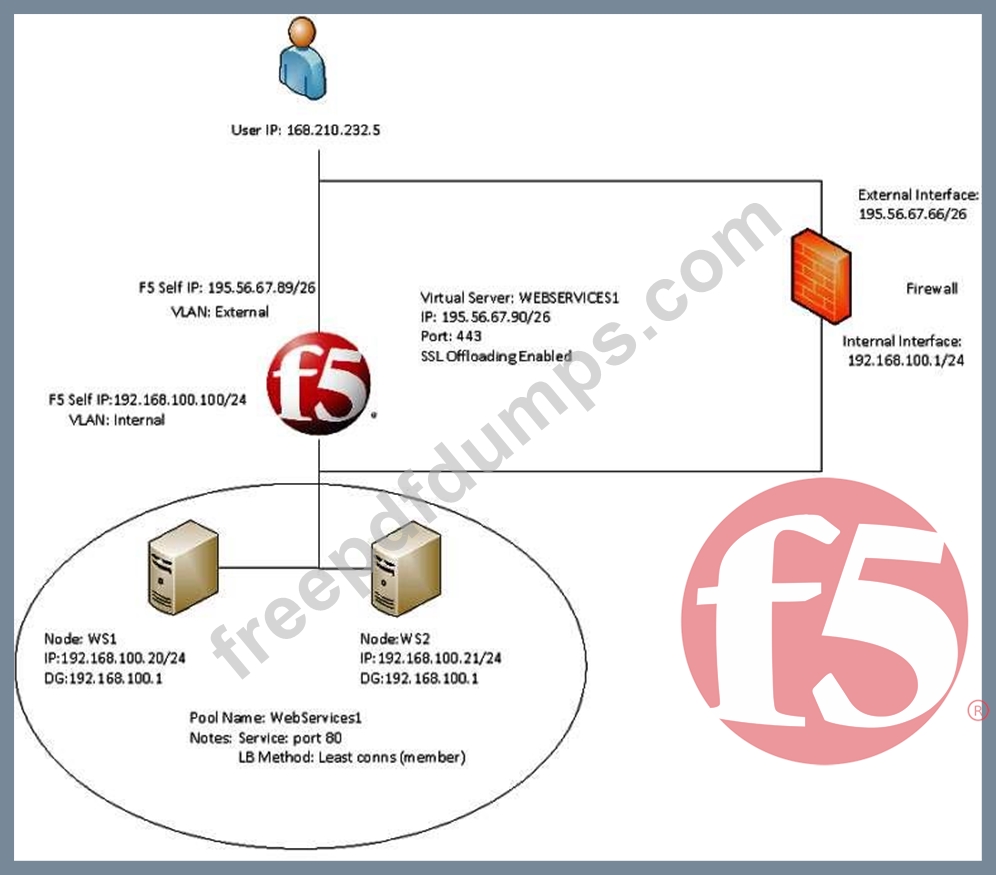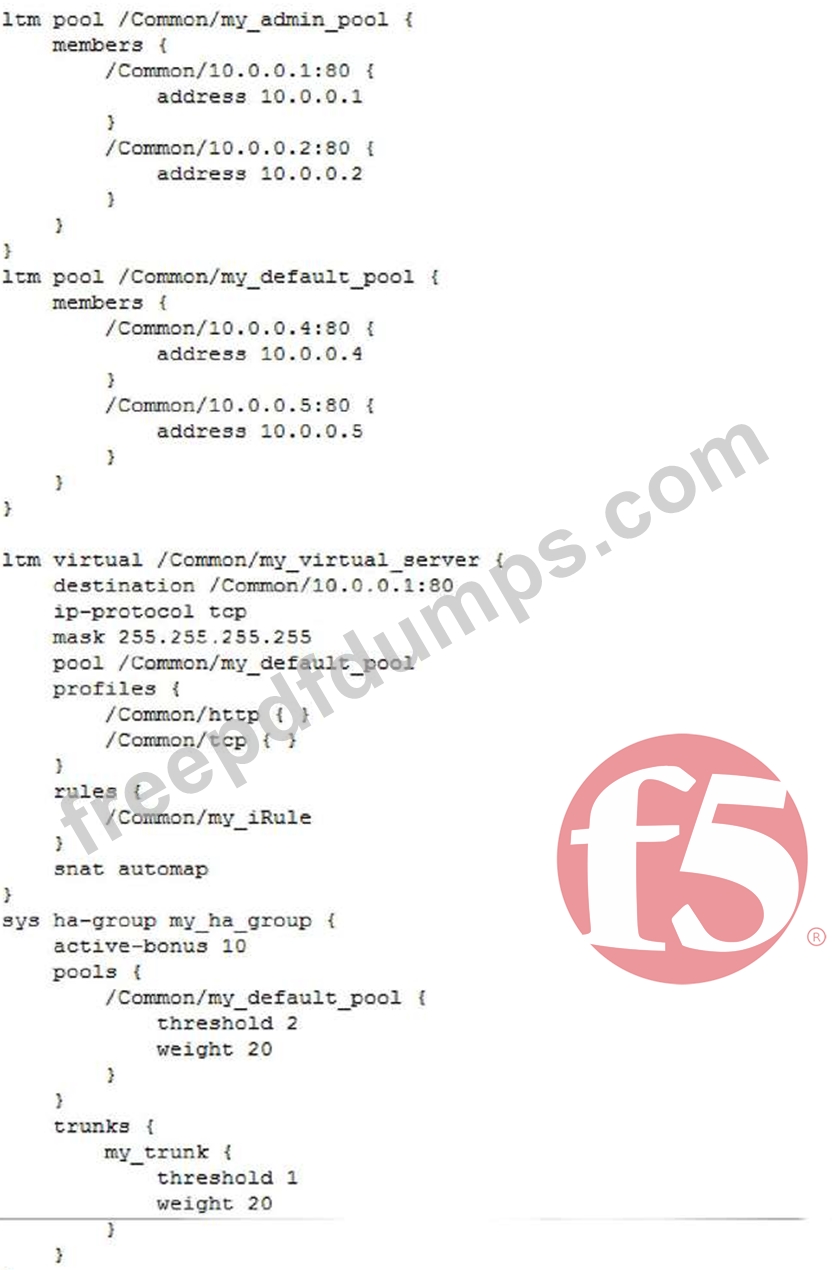301b Exam Question 51
An LTM Specialist notices the following error on the stdout console:
mcpd[2395]: 01070608:0: License is not operational(expired or digital signature does not match contents) Which command should be executed to verify the LTM device license?
mcpd[2395]: 01070608:0: License is not operational(expired or digital signature does not match contents) Which command should be executed to verify the LTM device license?
301b Exam Question 52
What is the recommended procedure for upgrading a major TMOS release on a BIG-IP platform?
301b Exam Question 53
-- Exhibit -

-- Exhibit --
Refer to the exhibit.
Users receive an error when attempting to connect to the website https://website.com. The website has a DNS record of 195.56.67.90. The upstream ISP has confirmed that there is nothing wrong with the routing between the user and the LTM device.
The following tcpdump outputs have been captured:
External Vlan, filtered on IP 168.210.232.5
00:25:07.598519 IP 168.210.232.5.33159 > 195.56.67.90.https: S 1920647964:1920647964(0) win 8192 <mss
1450,nop,nop,sackOK>
00:25:07.598537 IP 195.56.67.90.https > 168.210.232.5.33159: S 2690691360:2690691360(0) ack
1920647965 win 4350 <mss 1460,sackOK,eol>
00:25:07.598851 IP 168.210.232.5.33160 > 195.56.67.90.https: S 2763858764:2763858764(0) win 8192 <mss
1450,nop,nop,sackOK>
00:25:07.598858 IP 195.56.67.90.https > 168.210.232.5.33160: S 1905576176:1905576176(0) ack
2763858765 win 4350 <mss 1460,sackOK,eol>
Internal Vlan, filtered on IP 168.210.232.5
00:31:46.171124 IP 168.210.232.5.33202 > 192.168.100.20.http: S 2389057240:2389057240(0) win 4380
<mss 1460,nop,wscale 0,sackOK,eol>
What is the problem?

-- Exhibit --
Refer to the exhibit.
Users receive an error when attempting to connect to the website https://website.com. The website has a DNS record of 195.56.67.90. The upstream ISP has confirmed that there is nothing wrong with the routing between the user and the LTM device.
The following tcpdump outputs have been captured:
External Vlan, filtered on IP 168.210.232.5
00:25:07.598519 IP 168.210.232.5.33159 > 195.56.67.90.https: S 1920647964:1920647964(0) win 8192 <mss
1450,nop,nop,sackOK>
00:25:07.598537 IP 195.56.67.90.https > 168.210.232.5.33159: S 2690691360:2690691360(0) ack
1920647965 win 4350 <mss 1460,sackOK,eol>
00:25:07.598851 IP 168.210.232.5.33160 > 195.56.67.90.https: S 2763858764:2763858764(0) win 8192 <mss
1450,nop,nop,sackOK>
00:25:07.598858 IP 195.56.67.90.https > 168.210.232.5.33160: S 1905576176:1905576176(0) ack
2763858765 win 4350 <mss 1460,sackOK,eol>
Internal Vlan, filtered on IP 168.210.232.5
00:31:46.171124 IP 168.210.232.5.33202 > 192.168.100.20.http: S 2389057240:2389057240(0) win 4380
<mss 1460,nop,wscale 0,sackOK,eol>
What is the problem?
301b Exam Question 54
-- Exhibit -

-- Exhibit -
Refer to the exhibit.
A pair of LTM devices is configured for HA.
What happens if the pool member server with IP address 10.0.0.4 becomes totally unresponsive to the active LTM device, but is still responsive to the standby LTM device?

-- Exhibit -
Refer to the exhibit.
A pair of LTM devices is configured for HA.
What happens if the pool member server with IP address 10.0.0.4 becomes totally unresponsive to the active LTM device, but is still responsive to the standby LTM device?
301b Exam Question 55
An LTM device has a virtual server configured as a Performance Layer 4 virtual listening on
0.0.0.0:0 to perform routing of packets to an upstream router. The client machine at IP address
192.168.0.4 is attempting to contact a host upstream of the LTM device on IP address 10.0.0.99.
The network flow is asymmetrical, and the following TCP capture displays:
# tcpdump -nnni 0.0 'host 192.168.0.4 and host 10.0.0.99' tcpdump: verbose output suppressed, use -v or -vv for full protocol decode listening on 0.0, link-type EN10MB (Ethernet), capture size 96 bytes
05:07:55.499954 IP 192.168.0.4.35345 > 10.0.0.99.443: S 3205656213:3205656213(0) ack
3267995082 win 1480 05:07:55.499983 IP 10.0.0.99.443 > 192.168.0.4.35345: R 1:1(0) ack 1 win 0 05:07:56.499960 IP 192.168.0.4.35345 > 10.0.0.99.443: S 3205656213:3205656213(0) ack
3267995082 win 1480 05:07:56.499990 IP 10.0.0.99.443 > 192.168.0.4.35345: R 1:1(0) ack 1 win 0 4 packets captured
Which option within the fastL4 profile needs to be enabled by the LTM Specialist to prevent the LTM device from rejecting the flow?
0.0.0.0:0 to perform routing of packets to an upstream router. The client machine at IP address
192.168.0.4 is attempting to contact a host upstream of the LTM device on IP address 10.0.0.99.
The network flow is asymmetrical, and the following TCP capture displays:
# tcpdump -nnni 0.0 'host 192.168.0.4 and host 10.0.0.99' tcpdump: verbose output suppressed, use -v or -vv for full protocol decode listening on 0.0, link-type EN10MB (Ethernet), capture size 96 bytes
05:07:55.499954 IP 192.168.0.4.35345 > 10.0.0.99.443: S 3205656213:3205656213(0) ack
3267995082 win 1480 05:07:55.499983 IP 10.0.0.99.443 > 192.168.0.4.35345: R 1:1(0) ack 1 win 0 05:07:56.499960 IP 192.168.0.4.35345 > 10.0.0.99.443: S 3205656213:3205656213(0) ack
3267995082 win 1480 05:07:56.499990 IP 10.0.0.99.443 > 192.168.0.4.35345: R 1:1(0) ack 1 win 0 4 packets captured
Which option within the fastL4 profile needs to be enabled by the LTM Specialist to prevent the LTM device from rejecting the flow?

